Flat spotting occurs when a vehicle remains stationary for an extended period, causing the tires to develop flat areas on their surface.
This can lead to vibrations, reduced driving comfort, and potential damage if not addressed properly. Understanding the causes and solutions for flat-spotted tires is essential for maintaining vehicle performance and safety.
This guide on how to fix flat spotted tires will walk you through the steps to identify and fix flat spotting, ensuring a smoother and more secure driving experience.
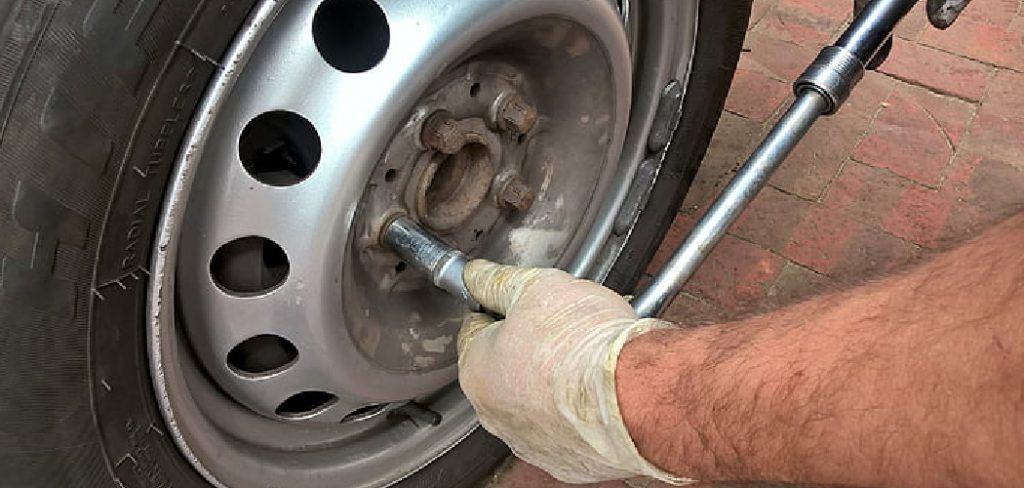
Why Do Tires Get Flat Spots
There are several reasons why tires can develop flat spots, including:
Prolonged Stationary Position:
When a vehicle is parked for an extended period, the weight of the car presses down on the tires. Over time, this constant pressure causes the rubber to deform and flatten in certain areas.
Over-Inflated Tires:
If tires are over-inflated, they become more susceptible to developing flat spots. The extra air pressure increases the stiffness of the tire’s sidewalls, making it easier for them to form a flat spot when stationary.
Cold Temperatures:
During cold weather, the rubber in tires becomes harder and less flexible, increasing the risk of flat spotting.
Old or Worn Tires:
As tires age, their rubber loses elasticity and becomes stiffer. This makes it easier for them to develop flat spots from prolonged stationary positions.
Needed Materials
To fix flat-spotted tires, you will need:
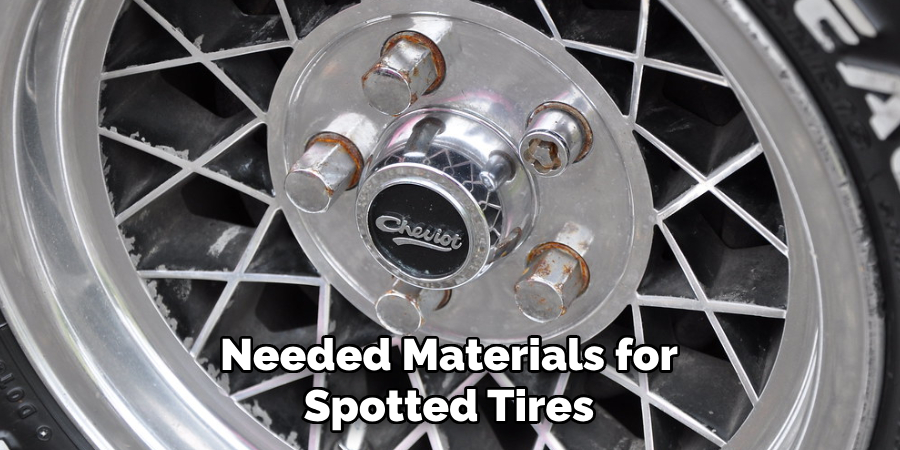
Jack and Jack Stands (or a Vehicle Lift):
A jack is used to lift the car off the ground, and jack stands or a vehicle lift are used to safely support the vehicle while working on the tires.
Tire Pressure Gauge:
This tool measures the air pressure in your tires. It is essential to have an accurate reading of tire pressure before making any adjustments.
Air Compressor (Optional):
If your tires are over-inflated, you will need an air compressor to release excess air and reduce tire pressure.
Towel:
A towel provides extra cushioning between the floor and tires when using a jack or jack stand.
8 Step-by-step Guidelines on How to Fix Flat Spotted Tires
Step 1: Locate the Flat Spots
Begin by thoroughly inspecting each tire to identify the flat spots. Roll the vehicle a few feet forward or backward and look for any irregularities or flattened areas on the tire surfaces. If the flat spots are not immediately visible, run your hands gently along the tire tread to feel for uneven sections.
Alternatively, take the vehicle for a slow test drive and pay attention to any vibrations or thumping sounds, which are common indicators of flat spotting. Accurately locating the flat spots is crucial before moving on to the next steps.
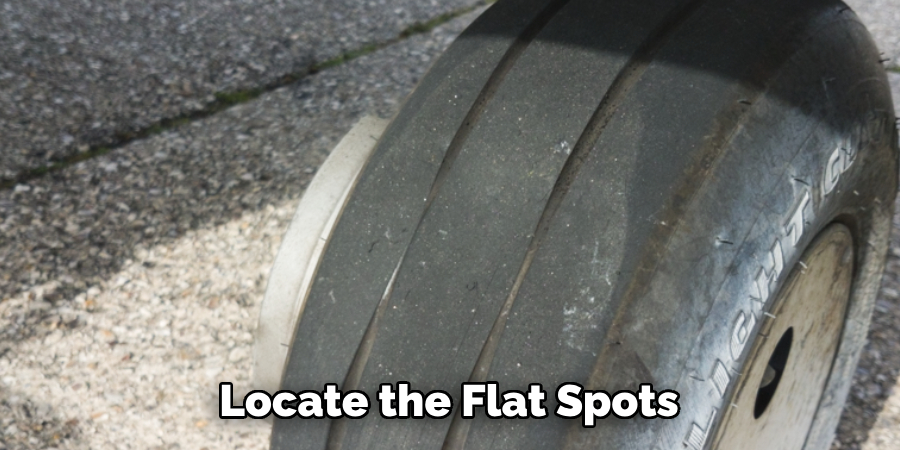
Step 2: Lift the Vehicle
Once the flat spots have been identified, the next step is to lift the vehicle safely. Park the vehicle on a flat, stable surface and engage the parking brake to prevent any movement. Use the jack to lift the vehicle at the appropriate lifting points recommended in the owner’s manual. Once the tire is off the ground, place the jack underneath the car to secure it.
Alternatively, if you have access to a vehicle lift, use it to raise the entire car. Ensuring the vehicle is stable and secure is essential for your safety while working on the tires.
Step 3: Measure Tire Pressure
Using the tire pressure gauge, check the air pressure in each tire. Compare the readings to the recommended pressure listed in your owner’s manual or on the inside of your car door. If the tire is over-inflated, use an air compressor to release excess air and reduce the pressure.
If you do not have access to an air compressor, carefully release small amounts of air using a valve stem tool until the desired pressure is reached. Repeat this step for all tires.
Step 4: Rotate Tires
One effective method for fixing flat spotted tires is to rotate them frequently. This means changing the positions of each tire on your vehicle so the flat spots are no longer in contact with the ground. Consult your owner’s manual for the recommended tire rotation pattern for your specific vehicle.
The most common rotation pattern is a cross-pattern, where the front tires move straight back while the rear tires move diagonally forward. This process ensures that each tire receives equal wear and reduces the risk of flat spotting.
Step 5: Drive at Higher Speeds
Another way to smooth out flat spotted tires is by driving at higher speeds for short periods. This technique helps to heat up the tires’ rubber, making it more pliable and allowing it to regain its shape. However, this method should only be used on safe roads with minimal traffic and never for an extended period or at excessive speeds.
You may notice some vibrations or thumping sounds during this process, but they should go away as the tires warm up.
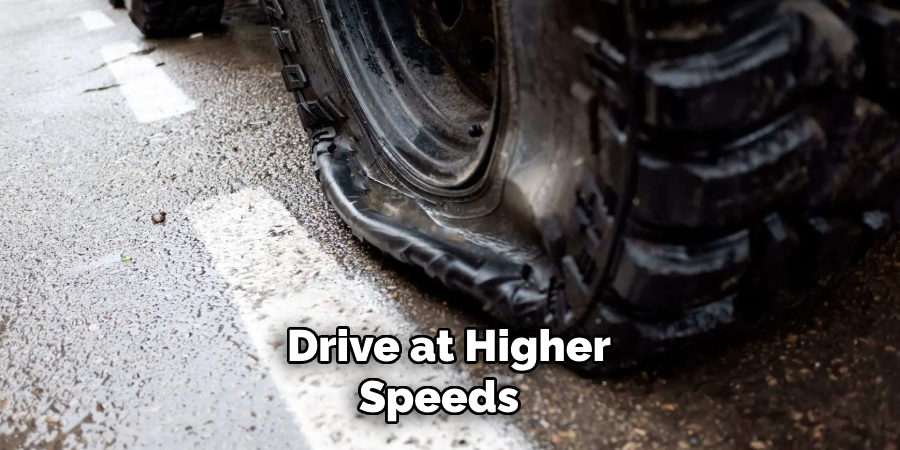
Step 6: Park on a Different Surface
If possible, try parking your vehicle on a different surface, such as grass or gravel, instead of asphalt or concrete. This change in terrain can help distribute the weight of the car more evenly and prevent flat spots from forming.
It is also recommended to avoid parking on hot asphalt for extended periods, as the heat can cause tires to soften and flatten more easily.
Step 7: Use Tire Warmers (Optional)
For vehicles used in motorsports or high-performance driving, tire warmers can be used to preheat the tires before use. This process helps maintain tire pressure and ensures the rubber is more flexible and less prone to flat spotting during races or intense driving sessions.
However, tire warmers may not be necessary or practical for everyday use.
Step 8: Regularly Inspect and Maintain Tires
To prevent flat spotting from occurring in the first place, it is essential to regularly inspect and maintain your tires. Check the air pressure at least once a month and adjust as needed. Rotate your tires according to the recommended schedule, and avoid prolonged stationary positions whenever possible.
Additionally, keeping your tires clean and free of debris can also help prevent flat spots from forming. Regular maintenance will not only prolong the life of your tires but also ensure a smoother ride overall.
Additional Tips
Use Tire Cradles or Parking Mats:
For vehicles that will be stationary for extended periods, consider using tire cradles or specialized parking mats. These accessories help evenly distribute the weight of the vehicle and reduce pressure on specific areas of the tires.
Consult a Professional:
If the flat-spotting does not improve with these methods or if you are unsure about performing these steps yourself, it is best to consult a professional mechanic. They can provide further advice or suggest alternative solutions to fix the issue.
Consider Replacing Tires:
In severe cases of flat spotting, where the tires cannot be repaired, it may be necessary to replace them altogether. This option should only be considered as a last resort and after consulting with a professional.
Taking proper care of your tires and regularly inspecting them can help prevent flat spots from forming. However, if you do encounter this issue, following these steps on how to fix flat spotted tires can help restore the shape and smoothness of your tires. Remember to always prioritize safety when working on your vehicle and seek professional assistance if needed.
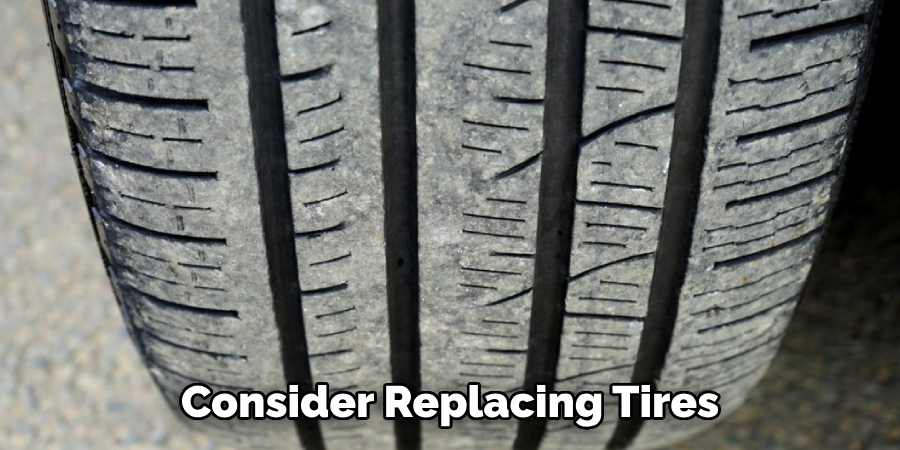
Frequently Asked Questions
Q: How Long Does It Take for a Flat Spot to Form on a Tire?
A: Flat spots can develop within hours, but they are more likely to occur after the vehicle has been stationary for an extended period, usually over 24 hours. It also depends on the weight of your vehicle and the type of tires you have.
Q: Can Flat Spots Be Fixed?
A: Yes, flat spots can be fixed with the proper tools and techniques. It is essential to address them as soon as possible to prevent further damage or permanent deformation.
Q: How Often Should Tires Be Rotated?
A: The general recommendation is to rotate tires every 5,000-7,000 miles or according to your vehicle’s maintenance schedule. However, it is always best to consult your owner’s manual for the specific rotation pattern and frequency recommended for your car model.
Q: Can Flat Spots Affect the Handling of My Vehicle?
A: Yes, flat spots can cause vibrations and affect the handling of your vehicle, especially at higher speeds. They can also lead to uneven tire wear, affecting your car’s overall performance and safety. It is crucial to address flat spots promptly to ensure a smooth and safe driving experience.
Conclusion
Fixing flat spotted tires is a straightforward process that requires following the proper steps and using the right tools. By identifying the flat spots, taking corrective actions such as rotating tires, driving cautiously, and maintaining proper tire pressure, you can restore your tires to optimal condition.
Prevention is equally crucial—regular inspection, tire maintenance, and mindful parking habits can greatly reduce the risk of flat spots forming. With consistent care, your tires will last longer, ensuring a safer and more comfortable driving experience. Thanks for reading this article on how to fix flat spotted tires
